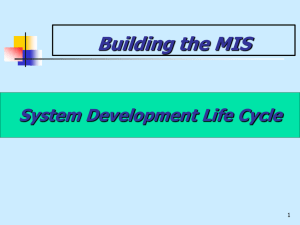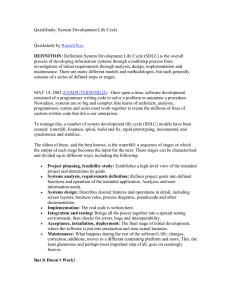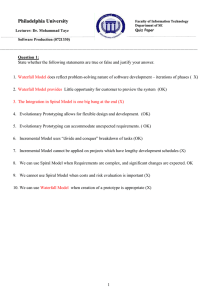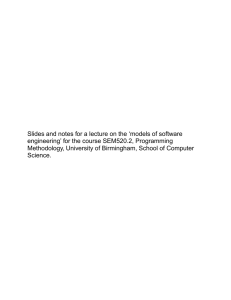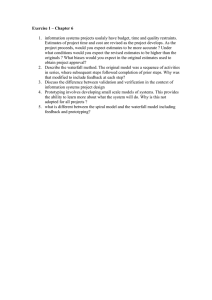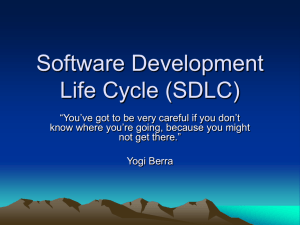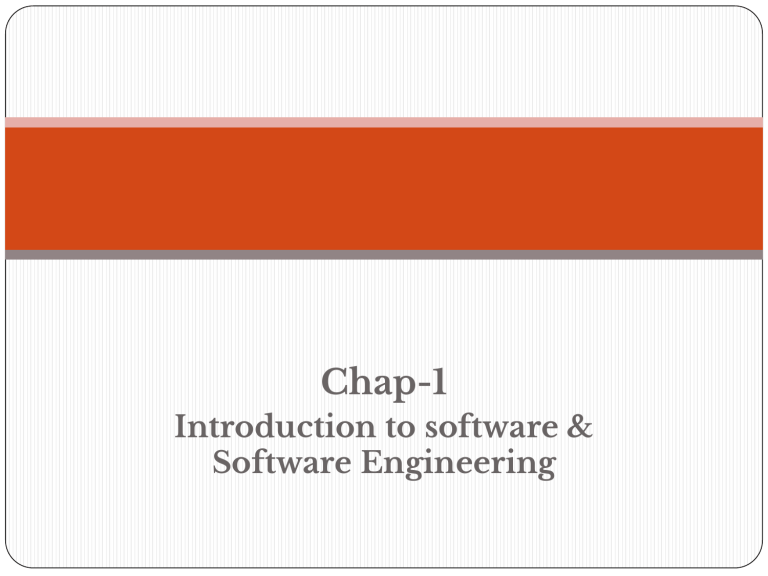
Chap-1 Introduction to software & Software Engineering Basic Terms ⚫ Program: A set of instructions that you give to a computer so that it will do a particular task ⚫ Process: In engineering, a process is a series of interrelated tasks that, together, transform inputs into a given output. ⚫ Software: Software is a collection of data or computer instructions that tell the computer how to work. ⚫ Software Engineering: Software engineering is defined as a process of analyzing user requirements and then designing, building, and testing software application. Software Characteristics ⚫ Functionality: It refers to the degree of performance of the software against its intended purpose. It basically means are the required functions. ⚫ Reliability: A set of attribute that Bear on the capability of software to maintain its level of performances understated conditions for a stated period of time. ⚫ Efficiency: It refers to the ability of the software to use System Resources in the most Effective and Efficient Manner. The software should make effective use of storage space and executive commands as per desired timing requirement. ⚫ Usability: It refers to the extent to which the software can be used with ease. Or the amount of effort or time required to learn how to use the software should be less. Continue… ⚫ Maintainability: Refers to the ease with which the modifications can be made in a software system to extend its functionality, improvement, performance or correct errors. ⚫ Portability: A set of attributes that bears on the ability of the software to be transferred from one environment to another, without or minimum changes. ⚫ Robustness: It refers to the degree to which the software can keep on functioning in spite of being provided with invalid data. ⚫ Integrity: It refers to the degree to which Unauthorized Access to the software data can be prevented. Software Development Life Cycle ⚫ Software Development Life Cycle (SDLC) is a process used by the software industry to design, develop and test high quality software. The SDLC aims to produce a high-quality software that meets or exceeds customer expectations, reaches completion within times and cost estimates. ⚫ It is also called as Software Development Process. ⚫ SDLC is a framework defining tasks performed at each step in the software development process. ⚫ ISO/IEC 12207 is an international standard for software life-cycle processes. It aims to be the standard that defines all the tasks required for developing and maintaining software. Continue… ⚫ What is SDLC? ⚫ SDLC is a process followed for a software project, within a software organization. It consists of a detailed plan describing how to develop, maintain, replace and alter or enhance specific software. The life cycle defines a methodology for improving the quality of software and the overall development process. Continue… ⚫ Stage 1: Planning and Requirement Analysis ⚫ Requirement analysis is the most important and fundamental stage in SDLC. It is performed by the senior members of the team with inputs from the customer, the sales department, market surveys and domain experts in the industry. This information is then used to plan the basic project approach and to conduct product feasibility study in the economical, operational and technical areas. ⚫ Stage 2: Defining Requirements ⚫ Once the requirement analysis is done the next step is to clearly define and document the product requirements and get them approved from the customer or the market analysts. This is done through an SRS (Software Requirement Specification) document which consists of all the product requirements to be designed and developed Continue… ⚫ Stage 3: Designing the Product Architecture ⚫ SRS is the reference for product architects to come out with the best architecture for the product to be developed. Based on the requirements specified in SRS, usually more than one design approach for the product architecture is proposed and documented in a DDS Design Document Specification. ⚫ This DDS is reviewed by all the important stakeholders and based on various parameters as risk assessment, product robustness, design modularity, budget and time constraints, the best design approach is selected for the product. ⚫ A design approach clearly defines all the architectural modules of the product along with its communication and data flow representation with the external and third party modules (if any). The internal design of all the modules of the proposed architecture should be clearly Continue… ⚫ Stage 4: Building or Developing the Product ⚫ In this stage of SDLC the actual development starts and the product is built. The programming code is generated as per DDS during this stage. If the design is performed in a detailed and organized manner, code generation can be accomplished without much hassle. ⚫ Developers must follow the coding guidelines defined by their organization and programming tools like compilers, interpreters, debuggers, etc. are used to generate the code. Different high level programming languages such as C, C++, Pascal, Java and PHP are used for coding. The programming language is chosen with respect to the type of software being developed. ⚫ Stage 5: Testing the Product ⚫ This stage is usually a subset of all the stages as in the modern SDLC models, the testing activities are mostly Continue… ⚫ Stage 6: Deployment in the Market and Maintenance ⚫ Once the product is tested and ready to be deployed it is released formally in the appropriate market. Sometimes product deployment happens in stages as per the business strategy of that organization. The product may first be released in a limited segment and tested in the real business environment (UAT- User acceptance testing). ⚫ Then based on the feedback, the product may be released as it is or with suggested enhancements in the targeting market segment. After the product is released in the market, its maintenance is done for the existing customer base. Software engineering - Layered technology ⚫ Software engineering is a fully layered technology. ⚫ To develop a software, we need to go from one layer to another. ⚫ All these layers are related to each other and each layer demands the fulfillment of the previous layer. Continue… ⚫ The layered technology consists of: ⚫ ⚫ ⚫ ⚫ ⚫ ⚫ ⚫ ⚫ ⚫ 1. Quality focus The characteristics of good quality software are: Correctness of the functions required to be performed by the software. Maintainability of the software Integrity i.e. providing security so that the unauthorized user cannot access information or data. Usability i.e. the efforts required to use or operate the software. 2. Process It is the base layer or foundation layer for the software engineering. The software process is the key to keep all levels together. It defines a framework that includes different activities and tasks. In short, it covers all activities, actions and tasks Continue… ⚫ 3. Methods ⚫ The method provides the answers of all 'how-to' that ⚫ ⚫ ⚫ ⚫ ⚫ ⚫ are asked during the process. It provides the technical way to implement the software. It includes collection of tasks starting from communication, requirement analysis, analysis and design modelling, program construction, testing and support. 4. Tools The software engineering tool is an automated support for the software development. The tools are integrated i.e the information created by one tool can be used by the other tool. For example: The Microsoft publisher can be used as a web designing tool. Software Process Framework ⚫ The process of framework defines a small set of activities that are applicable to all types of projects. The software process framework is a collection of task sets.Task sets consist of a collection of small work tasks, project milestones, work productivity and software quality assurance points. Continue… ⚫ Umbrella activities ⚫ Typical umbrella activities are: ⚫ ⚫ ⚫ ⚫ ⚫ ⚫ ⚫ 1. Software project tracking and control In this activity, the developing team accesses project plan and compares it with the predefined schedule. If these project plans do not match with the predefined schedule, then the required actions are taken to maintain the schedule. 2. Risk management Risk is an event that may or may not occur. If the event occurs, then it causes some unwanted outcome. Hence, proper risk management is required. 3. Software Quality Assurance (SQA) SQA is the planned and systematic pattern of activities which are required to give a guarantee of software Continue… ⚫ For example, during the software development meetings ⚫ ⚫ ⚫ ⚫ ⚫ ⚫ ⚫ ⚫ ⚫ are conducted at every stage of development to find out the defects and suggest improvements to produce good quality software. 4. Formal Technical Reviews (FTR) FTR is a meeting conducted by the technical staff. The motive of the meeting is to detect quality problems and suggest improvements. The technical person focuses on the quality of the software from the customer point of view. 5. Measurement Measurement consists of the effort required to measure the software. The software cannot be measured directly. It is measured by direct and indirect measures. Direct measures like cost, lines of code, size of software etc. Indirect measures such as quality of software which is measured by some other factor. Hence, it is an indirect measure of software. Continue… ⚫ 6. Software Configuration Management (SCM) ⚫ It manages the effect of change throughout the software ⚫ ⚫ ⚫ ⚫ ⚫ process. 7. Reusability management It defines the criteria for reuse the product. The quality of software is good when the components of the software are developed for certain application and are useful for developing other applications. 8. Work product preparation and production It consists of the activities that are needed to create the documents, forms, lists, logs and user manuals for developing a software. Generic Process Model ⚫ A software process is a collection of various activities. There are five generic process framework activities: 1. Communication: The software development starts with the communication between customer and developer. 2. Planning: It consists of complete estimation, scheduling for project development and tracking. 3. Modeling: ⚫ Modeling consists of complete requirement analysis and the design of the project like algorithm, flowchart etc. ⚫ The algorithm is the step-by-step solution of the problem and the flow chart shows a complete flow diagram of a program. Continue… ⚫ 4. Construction: ⚫ Construction consists of code generation and the testing ⚫ ⚫ ⚫ ⚫ ⚫ ⚫ part. Coding part implements the design details using an appropriate programming language. Testing is to check whether the flow of coding is correct or not. Testing also check that the program provides desired output. 5. Deployment: Deployment step consists of delivering the product to the customer and take feedback from them. If the customer wants some corrections or demands for the additional capabilities, then the change is required for improvement in the quality of the software. Prescriptive Process Models ⚫ The following framework activities are carried out irrespective of the process model chosen by the organization. 1. Communication 2. Planning 3. Modeling 4. Construction 5. Deployment ⚫ The name 'prescriptive' is given because the model prescribes a set of activities, actions, tasks, quality assurance and change the mechanism for every project. ⚫ There are three types of prescriptive process models. They are: 1. The Waterfall Model 2. Incremental Process model 3. RAD model 1. The Waterfall Model ⚫ The waterfall model is also called as 'Linear sequential ⚫ ⚫ ⚫ ⚫ model' or 'Classic life cycle model'. In this model, each phase is fully completed before the beginning of the next phase. This model is used for the small projects. In this model, feedback is taken after each phase to ensure that the project is on the right path. Testing part starts only after the development is complete. Continue… ⚫ An alternative design for 'linear sequential model' is as follows: Continue… ⚫ Advantages of waterfall model ⚫ The waterfall model is simple and easy to understand, ⚫ ⚫ ⚫ ⚫ implement, and use. All the requirements are known at the beginning of the project, hence it is easy to manage. It avoids overlapping of phases because each phase is completed at once. This model works for small projects because the requirements are understood very well. This model is preferred for those projects where the quality is more important as compared to the cost of the project. Continue… ⚫ Disadvantages of the waterfall model ⚫ This model is not good for complex and object oriented projects. ⚫ It is a poor model for long projects. ⚫ The problems with this model are uncovered, until the software testing. ⚫ The amount of risk is high. 2. Incremental Process model ⚫ The incremental model combines the elements of ⚫ ⚫ ⚫ ⚫ waterfall model and they are applied in an iterative fashion. The first increment in this model is generally a core product. Each increment builds the product and submits it to the customer for any suggested modifications. The next increment implements on the customer's suggestions and add additional requirements in the previous increment. This process is repeated until the product is finished. For example, the word-processing software is developed using the incremental model. Continue… Continue… ⚫ Advantages of incremental model ⚫ This model is flexible because the cost of development ⚫ ⚫ ⚫ ⚫ ⚫ ⚫ ⚫ is low and initial product delivery is faster. It is easier to test and debug during the smaller iteration. The working software generates quickly and early during the software life cycle. The customers can respond to its functionalities after every increment. Disadvantages of the incremental model The cost of the final product may cross the cost estimated initially. This model requires a very clear and complete planning. The planning of design is required before the whole 3. RAD model ⚫ RAD is a Rapid Application Development model. ⚫ Using the RAD model, software product is developed in ⚫ ⚫ ⚫ ⚫ ⚫ ⚫ a short period of time. The initial activity starts with the communication between customer and developer. Planning depends upon the initial requirements and then the requirements are divided into groups. Planning is more important to work together on different modules. 1. Business Modeling Business modeling consist of the flow of information between various functions in the project. For example what type of information is produced by every function and which are the functions to handle that information. Continue… ⚫ A complete business analysis should be performed to ⚫ ⚫ ⚫ ⚫ ⚫ ⚫ get the essential business information. 2. Data modeling The information in the business modeling phase is refined into the set of objects and it is essential for the business. The attributes of each object are identified and define the relationship between objects. 3. Process modeling The data objects defined in the data modeling phase are changed to fulfil the information flow to implement the business model. The process description is created for adding, modifying, deleting or retrieving a data object. Continue… ⚫ 4. Application generation ⚫ In the application generation phase, the actual system is ⚫ ⚫ ⚫ ⚫ built. To construct the software the automated tools are used. 5. Testing and turnover The prototypes are independently tested after each iteration so that the overall testing time is reduced. The data flow and the interfaces between all the components are are fully tested. Hence, most of the programming components are already tested. Continue… Evolutionary Process Models ⚫ Evolutionary models are iterative type models. ⚫ They allow to develop more complete versions of the software. ⚫ Following are the evolutionary process models. 1. The prototyping model 2. The spiral model 3. Concurrent development model 1. The Prototyping model ⚫ Prototype is defined as first or preliminary form using ⚫ ⚫ ⚫ ⚫ which other forms are copied or derived. Prototype model is a set of general objectives for software. It does not identify the requirements like detailed input, output. It is software working model of limited functionality. In this model, working programs are quickly produced. Continue… ⚫ The different phases of Prototyping model are: ⚫ ⚫ ⚫ ⚫ ⚫ ⚫ ⚫ 1. Communication In this phase, developer and customer meet and discuss the overall objectives of the software. 2. Quick design Quick design is implemented when requirements are known. It includes only the important aspects like input and output format of the software. It focuses on those aspects which are visible to the user rather than the detailed plan. It helps to construct a prototype. 3. Modeling quick design This phase gives the clear idea about the development of software because the software is now built. It allows the developer to better understand the exact Continue… ⚫ 4. Construction of prototype ⚫ ⚫ ⚫ ⚫ ⚫ ⚫ ⚫ The prototype is evaluated by the customer itself. 5. Deployment, delivery, feedback If the user is not satisfied with current prototype then it refines according to the requirements of the user. The process of refining the prototype is repeated until all the requirements of users are met. When the users are satisfied with the developed prototype then the system is developed on the basis of final prototype. Advantages of Prototyping Model Prototype model need not know the detailed input, output, processes, adaptability of operating system and full machine interaction. In the development process of this model users are actively involved. Continue… ⚫ The development process is the best platform to ⚫ ⚫ ⚫ ⚫ ⚫ ⚫ ⚫ ⚫ understand the system by the user. Errors are detected much earlier. Gives quick user feedback for better solutions. It identifies the missing functionality easily. It also identifies the confusing or difficult functions. Disadvantages of Prototyping Model: The client involvement is more and it is not always considered by the developer. It is a slow process because it takes more time for development. Many changes can disturb the rhythm of the development team. It is a thrown away prototype when the users are confused with it. 2. The Spiral model ⚫ Spiral model is a risk driven process model. ⚫ It is used for generating the software projects. ⚫ In spiral model, an alternate solution is provided if the risk is found in the risk analysis, then alternate solutions are suggested and implemented. ⚫ It is a combination of prototype and sequential model or waterfall model. ⚫ In one iteration all activities are done, for large project's the output is small. ⚫ The framework activities of the spiral model are as shown in the following figure. Continue… Continue… ⚫ Advantages of Spiral Model ⚫ It reduces high amount of risk. ⚫ It is good for large and critical projects. ⚫ It gives strong approval and documentation control. ⚫ In spiral model, the software is produced early in the life cycle process. ⚫ Disadvantages of Spiral Model ⚫ It can be costly to develop a software model. ⚫ It is not used for small projects. 3. The concurrent development model ⚫ The ⚫ ⚫ ⚫ ⚫ concurrent development model is called as concurrent model. The communication activity has completed in the first iteration and exits in the awaiting changes state. The modeling activity completed its initial communication and then go to the underdevelopment state. If the customer specifies the change in the requirement, then the modeling activity moves from the under development state into the awaiting change state. The concurrent process model activities moving from one state to another state. Continue… Continue… ⚫ Advantages of the concurrent development model ⚫ This model is applicable to all types of software ⚫ ⚫ ⚫ ⚫ ⚫ ⚫ development processes. It is easy for understanding and use. It gives immediate feedback from testing. It provides an accurate picture of the current state of a project. Disadvantages of the concurrent development model It needs better communication between the team members. This may not be achieved all the time. It requires to remember the status of the different activities.
